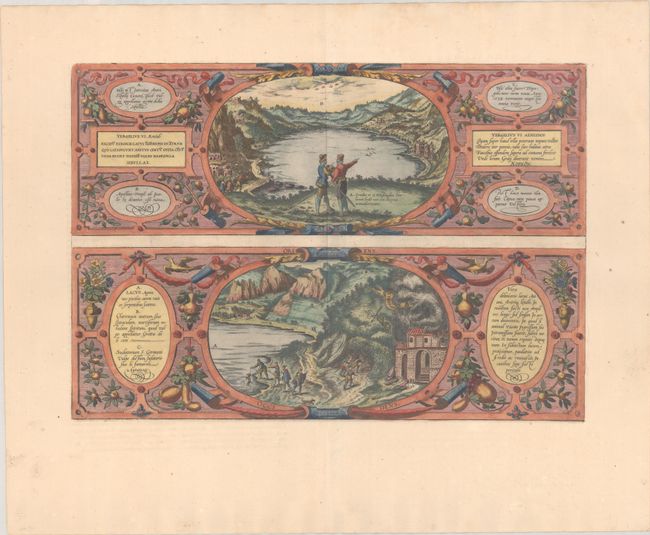Subject: Southern Italy, Lake Averno & Lake Agnano
Period: 1581 (circa)
Publication: Civitates Orbis Terrarum, Vol. III
Color: Hand Color
Size:
18.5 x 12.9 inches
47 x 32.8 cm
Braun & Hogenberg's Civitates Orbis Terrarum or "Cities of the World" was published between 1572 and 1617. Within the six volumes, 531 towns and cities were depicted on 363 plates, providing the reader with the pleasures of travel without the attendant discomforts. Braun wrote in the preface to the third book, "What could be more pleasant than, in one's own home far from all danger, to gaze in these books at the universal form of the earth . . . adorned with the splendor of cities and fortresses and, by looking at pictures and reading the texts accompanying them, to acquire knowledge which could scarcely be had but by long and difficult journeys?" Braun and Hogenberg incorporated an astonishing wealth of information into each scene beyond the city layout and important buildings. The plates provide an impression of the economy and prominent occupations, and illustrate local costumes, manners and customs.
This very interesting and unusual sheet consists of two views drawn by Georg Hoefnagel, one atop the other. Each is surrounded by an elaborate strapwork framework with descriptive text. Latin text on verso.
The top view is of Lake Averno from the east, showing the entrance to the Grotto of the Cumaean Sibyl (marked as "A"), and the temple of Apollo (marked as "B"). At center, Hoefnagel and Ortelius discuss the ancient context to the name of the lake, which means "birdless" in Greek. Yet Hoefnagel points out the ducks swimming in the lake, thereby disputing the claim that the lake was the entrance to the Underworld, as previously believed.
The bottom view is of the volcanic Lake Agnano. The cartouche at right is translated as: "A true delineation of Lake Agnano and the deadly cave, which is neither spacious nor does it penetrate deeply into the mountain, but slopes gently towards the north. If any living creature enters it or is sent in, it will die at once; but if it is immediately pulled out and thrown into the aforementioned lake, it will slowly recover and come to life again. This is often tried out with dogs." Along Lake Agnano is the Grotta del Cane (Dog's Cave, marked "B"), which received its name due to the gases that rise approximately 45 cm from the floor, such that any dog who entered would be rendered unconscious. The structure to the far right of the lake (marked "C") is the Stufe di San Germano, where the hot sulphur gases are stored for medicinal purposes.
References: Fussel, pp. 265-67; Van der Krogt (Vol. IV) #46.
Condition: A
A crisp impression with wide original margins. There are a few light extraneous creases and minor foxing confined to the blank margins.


